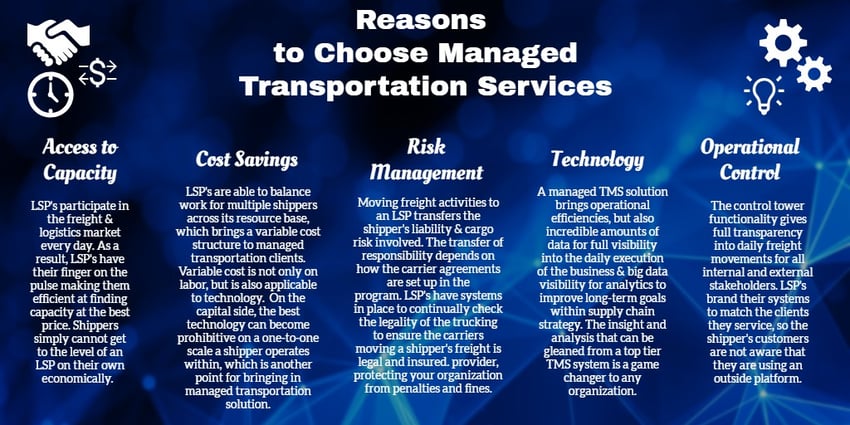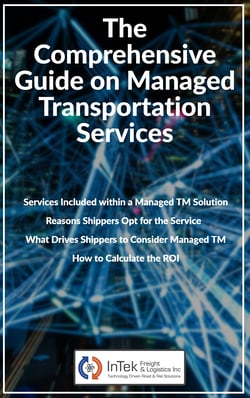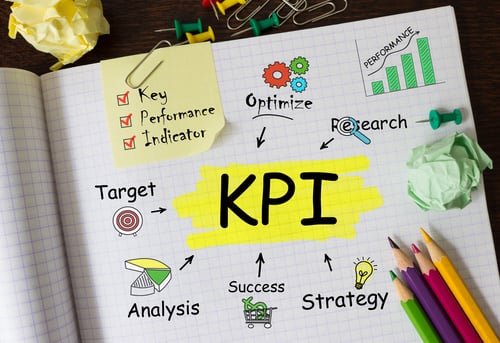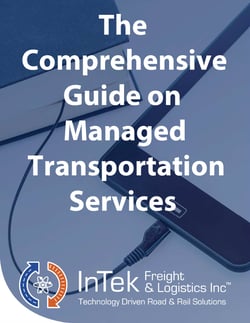
Chapters

Definition of Freight Management
The technical definition of freight management is where a shipper hires a logistics service provider (LSP) to efficiently and strategically move freight across its network of customers (outbound) and vendors (inbound) using various modes of transportation, intermediaries, and technologies by employing their logistics and supply chain expertise and assets.
A freight management logistics service solution brings together everything a logistics service provider has done internally to build its business profitability through consistently delivering a solid service at a value price for the shipping community and bundles it into a service module that it then sells to shippers.
The essence of freight management is the shipper is getting a packaged service program that is the playbook the logistic provider has perfected, while operating its own business.

By employing the playbook the shipper will accelerate and transform its logistics and supply chain execution and strategy into a competitive advantage with higher service levels, more capacity and a lower all-in cost, which are the three main goals of all logistics professionals.
Encompassed in the service bundle is a cloud transportation management (TMS) technology platform, consistent and repeatable process, and human capital. Plus, there's knowledge leveraged that facilitates effective, efficient and expeditious coordination between carriers and shippers and ensures the shipper’s products are delivered within budget and on-time.
The end result shippers like to hear is the professional logistics team of experts is on hand 24/7/365 to manage the logistics process with speed and consistency that results in better service, greater predictability and lower total costs.
Various Names Given to Freight Management
For years freight management has come in different flavors as logistics service providers (LSP) try their best to explain what their bundled service solution plan is and what it does for its clients.
Program names shippers will find when Googling these programs will include:
- Managed TMS
- Transportation Management Services
- Inbound Freight Management
- Outbound Freight Management
- Managed Logistics Services
- Supply Chain Management
- Managed TM
- Managed Transportation Services
The lack of our industry locking down the name for outsourcing the execution and management of a shipper’s freight program not only confuses everyone, but also makes it difficult for the shippers to find the best service provider for their company because they are not getting the full listing of companies that provide the service.
In addition to not finding the best company for their specific needs, many shippers do not have a full understanding of what a freight management program is and why it is such a beneficial service solution for their company’s various logistics and supply chain challenges they’ve been trying to solve for years.
Evolution of Freight Management Programs
The last overview topic of freight management before jumping into the nitty, gritty details of the service logistics providers provide is to understand how freight management programs came to be and where they sit in the logistics service tiers.
Freight management service programs came about as freight brokers and the top transportation management software (TMS) systems upped their game. As TMS technology began to move beyond one-for-one transactions; the amount of data available to capture grew and the transition of the TMS platform to the cloud changed the game.
What it did is turn a freight system with mountains of transactions into one of data that users could automate to learn and predict events through intensified reporting and analysis. What then followed was the advent of the freight management service solutions market where logistics providers bottled their magic and sold it to shippers. The service came at a much lower price than a shipper could purchase a top tier TMS themselves, while it also brought tremendous savings to the shipping community on freight rates and operational expenses.

Questions on Freight Management Answered in this Article
We are here to say the confusion on the naming convention may never end, but what a freight management service solution is will be cleared up over the next several pages where we will answer the who, what, where, when, why, how and cost of freight management programs.
- What is freight management?
- What all is included in freight management service solutions?
- What should my company be looking for in a logistics and supply chain program freight management program?
- What are the benefits of a freight management service solution?
- What are the pros and cons of a freight management outsourced logistics solution?
- Who are the largest providers and why may they or may they not be a good fit for your company?
- Who benefits from freight management?
- When should you or should you not consider a freight management service?
- Why would my company want to move its freight management to an LSP?
- How much does a freight management service solution cost and save?
- How does freight management work?
- How does a freight management service get implemented?
- How long does it take to get a freight management service implemented?
- What are some of the pros and cons that we need to consider on a freight management program?
- Why do LSPs and 3PLs like the freight management business model?
- Why has freight management become such an important component of business?


Ebook: Comprehensive Guide on Managed Transportation
Download A Free Copy of Our eBook "Comprehensive Guide on Managed Transportation" to discover managed TMS will add capacity, reduce costs and improve logistics performance.
A study put out by the Aberdeen Group found 83% of companies interviewed have become aware of the cost and service impact transportation has on the overall supply chain performance of their company and see transportation as more than just an isolated budget line item to be monitored. The strategy many shippers have taken to change results for the better is bring a managed transportation service strategy through a well-respected logistics service provider.


The ability to deliver freight on time to the right destination, in the right quantity, damage-free, efficiently, report on it, and all at the lowest possible cost, has always been critically important to businesses.
Today’s complex supply chain companies have elevated the need for businesses to employ the best possible logistics and supply chains execution and strategies.
Operating in highly competitive markets, they strive to meet customers where they are in their buying requirements.
By having an efficient supply chain, a company can operate with leaner inventories, just-in-time manufacturing, tighter delivery windows, omni channel distribution strategy and higher consumer fulfillment expectations driven by ecommerce, while driving down operating costs in what continue to be very difficult freight markets.

Reasons Why Companies Employ a Freight Management Company
While the three key components companies drive their logistics and supply teams to are lower freight and operating costs, better access to freight capacity and higher service levels, there are numerous reasons why shippers decide to work with a third party logistics company to execute a freight management service solution.
So, the drivers are always the same, but the reasoning behind the actual decision for every company to outsource freight management is different.
Below are the most common drivers of why companies turn to a freight management service:

- Service KPIs Suffering
- New Technology Required
- Increasing Logistics Costs
- Operating
- Freight
- Project or Seasonal Volume Spikes that Cannot be Managed Internally
- Continuous Growth that Becomes Harder to Support Internally
- Business Model Changes
- Geographic Changes
- Business Matures
- Change in Key Personnel
- Launching a New Service or Product Within the Business
- Desire to Manage Inbound Freight for Cost and Process Flow in Combination with Outbound Freight Flows

Basics of Freight Management
While there are several facets of a freight management service solution which will be covered shortly, the essence of the program on a daily basis is the logistics service provider (LSP) plans, executes and manages the shipper’s motor carrier contracts on its behalf.
So, instead of the shipper’s own internal personnel planning and executing their freight shipments, they are leveraged by the LSP that works on the shipper’s behalf.
At the onset of a freight management program, the logistics provider performs an RFQ (request for quotation) to negotiate the motor carrier capacity and rate commitments for the program, which is used to build out the shipper’s network requirements.
The rates the LSP assembles on the shipper’s behalf are the freight rates directly from the motor carrier, meaning a margin is not added onto the freight rate structure. This provides full transparency on the actual rates a shipper will be paying. As part of this process, the logistics provider will assist in the signing of the motor carrier - shipper contract.
We’ll get more into savings and pricing later in this article, but it does make sense to make a quick comment on the freight contract pricing. As mentioned, the freight rates used in the freight management program are the actual rates, making this one of the first areas shippers will save on their total freight spend. The logistics provider makes its money on a service fee, which is at a much lower percentage than what they would charge as a freight broker in a shipper - broker arrangement where typical industry margins are:
- Truckload: 8-12%
- Intermodal: 6-8%
- LTL: 12-18%
- Expedited: 15% and up
Details on Logistics & Supply Chain Services Provided within a Freight Management Service Solution
Whether freight management is called MTS, Managed TMS or Transportation Management Services it all operates essentially the same, which the below graphic outlines in great detail.
Over the next several paragraphs we will take a deeper dive breaking down the details further.
1. Business Process Outsourcing
First and foremost, freight management is outsourcing the freight execution from tender through final settlement with the motor freight carrier.
The logistics provider brings a shipper’s inbound and outbound freight movements into its TMS to maximize the best service at the least possible cost.
Quite often a shipper will have an outbound freight management or an inbound freight management program, so they can be split. But for the best results, we recommend pulling it all together for the deepest and most transparent supply chain intelligence possible.
To sum it up, the LSP plans and executes freight across the various company silos to drive for as close to a seamless logistics and supply chain as possible.
2. Client Network Collaboration
Under this category, the LSP pulls together all freight moves to optimize a shipper’s supply chain network for best service and price.
The TMS is the facilitator of the flow of data and information bringing together the key stakeholders in the supply chain: vendors, customers, freight carriers, operations, etc.
3. Strategic Carrier Management & RFP Execution
If you pull nothing more from this article please know freight savings, more fluid capacity and better service does not come through an annual RFP with internally focused targets.
Freight savings comes through a well thought out strategic approach to the market, while also including all stakeholders that touch inbound and outbound freight shipments.
More on Strategic Carrier Management & RFP Execution Under Freight Management Programs
The other ingredient to include in the RFP process is that of a market benchmark. These come through any number of freight consortiums that pull in millions of freight transactions comprising billions of dollars spent throughout the year.
Combining both a strategic plan and benchmark, then going to market with a story to share with the freight community at the “right time” will drive the best rates and capacity.
The “right time” would not be in the 4th quarter or at any “peak” during the year. Freight pricing tends to be done on what is known versus the unknown. For whatever reason, pricing teams tend to think the cyclical freight market is always going up and peaks always remain in style.
Please see the example below where that is clearly not the case.
To add to the discussion on the strategic direction of carrier management, those in the industry know the shippers that have smooth running docks and stick to their word as well as those that flip from year-to-year. So they do price accordingly. That means it may take a couple of years before the full fruits of your labor come through all aspects of your organization.
We see the above situation many times where we could not bring everything together for our client until the second year because of prior bad habits, even for those companies that were under a freight management program with another of the top service providers.
The bad habits could be payments, not having carrier friendly docks, or being a known flipper on carriers brought into the business every year.
4. Carrier & Modal Solutions
 As part of the daily execution of business by the 3PL, the TMS used for the freight management program shops the best contract and service on the lane for what is called waterfall tendering. In these cases, the contract carriers are given the opportunity to accept a load tender based on price and its availability.
As part of the daily execution of business by the 3PL, the TMS used for the freight management program shops the best contract and service on the lane for what is called waterfall tendering. In these cases, the contract carriers are given the opportunity to accept a load tender based on price and its availability.
Also under the shipment execution and management side of the equation, the shipper’s total volume and delivery requirements are analyzed within the TMS for freight consolidation and modal conversion opportunities to save freight costs.
5. Real-Time End-to-End Visibility
Under today’s sophisticated logistics and supply chains the data is often more important than the shipment itself. Real-time visibility is a critical piece of the data flowing into and out of the TMS.
With it customer service and sales can report to its customer when to expect their shipments and purchasing can inform its operations team when to expect the goods for manufacturing or shipment.
The freight management company uses the real-time visibility to ensure timely pick-ups and deliveries to meet the requirements outlined by its client. At times that requires the freight management provider to recover what is on track to be a failure based on algorithms and electronic transmissions from the carrier base, although the majority of shipments move through as planned.
6. Reporting
Again, data is often viewed to be just as important as the shipment itself.
Freight management reporting benchmarks the progress of the freight management service solution against contractual KPIs, the freight management provider, the carriers in the program and the behaviors of all the other stakeholders in the execution of the supply chain.
The reporting also gives key details on what worked and what did not work that drive the continuous improvement flywheel effect of the freight management program.
More on Reporting
A few of the critical data points required for continuous improvement in a supply chain include:
- Tender acceptance rate of the motor carriers on each freight lane
- The litmus test is having the right carriers on the lanes to perform to the highest service levels and best price
- The percentage the freight management program can execute shipments with the contracted carrier base
- The depth and strength of the carrier base is critical to stay out of the highly volatile freight spot market
- There should not be more than 2.5 to 3% of the freight moving outside of the contractual motor carrier base established for the freight management program
- The depth and strength of the carrier base is critical to stay out of the highly volatile freight spot market
- On-time pickup and delivery percentages
- This is the measurement for service
- It also can provide insight as to the performance of various shipping or receiving docks
- Freight costs by lane versus the price other shippers are paying in the same freight lanes
- Many view this as the key to how well a freight management program is being operated
- The point here is to keep an eye on internal commitments and also the market rates, which can be reviewed through the various freight rate consortiums that only the best freight management companies access
The above are the critical measurements to evaluate for moving the program forward in cost and service. And yes, there are plenty more KPIs that should and will be measured in a freight management program.
7. Tender and Shipment Management
Tender and shipment management is the blocking and tackling process of moving the shipper’s freight and the transportation management system the logistics service provider utilizes does the heavy lifting.
The key components of tender and shipment management are order management, load planning, appointment scheduling and event & exception management.
More on Tender and Shipment Management
The TMS can take in the shipper’s freight move requirements by ready date and required delivery date, the walks through the process in the follow manner to optimize cost and service:
- Optimize for freight consolidation and pooling opportunities
- Evaluate modal conversions, like moving freight from truckload to intermodal
- Manage the waterfall tenders through to the contract carriers until the freight is 100% accepted
.jpg?width=400&name=Woman%20Laptop%20Office%20(1).jpg) While the tendering process is the operation that builds the shipping plan for best service and price, the management of the shipments after the loads have all been booked is the critical piece of freight management which again the TMS does the heavy lifting. The transportation management software system is constantly receiving shipment statuses from the carriers moving the freight under the freight management program. The TMS takes this information and does its work analyzing potential shortcomings in the statuses received to create exception reporting that indicates shipments with potential failures.
While the tendering process is the operation that builds the shipping plan for best service and price, the management of the shipments after the loads have all been booked is the critical piece of freight management which again the TMS does the heavy lifting. The transportation management software system is constantly receiving shipment statuses from the carriers moving the freight under the freight management program. The TMS takes this information and does its work analyzing potential shortcomings in the statuses received to create exception reporting that indicates shipments with potential failures.
The various potential failure reports are the exceptions where human intervention is required to ensure the shipment makes the required delivery window. The dedicated service team, which is a hallmark of the freight management program, is the group that manages the exception through additional communications to the carriers to understand the situations and whether a recovery is required or the freight will still be a successful on-time delivery.
The dedicated freight management service team is far more adept at monitoring its freight and knowing the levers to pull for the best possible KPIs because it knows the characteristics inside and out. A freight management client can rest easy by having their dedicated team in place and if there are questions they do not go into the general pool of support in off hours that historically is the weakest link in the standard logistics operational models (by task and shift set-up) the largest non-asset freight companies operate.
Before moving on from the tender and shipment management process of a freight management program it is important to revisit the freight optimization comment on the potential of it being no more than a really cool three dimensional math equation. This is not an uncommon situation as many freight optimization software is nothing more than a math optimizer because either it is very limited in what it considers in its calculations and / or the person running the optimizer is not well versed in how freight really operates, so they miss activities that would cause the optimized freight plan to be nothing more than a useless paperweight.
8. Freight Audit & Payment Services
Freight payment is the final step taken in a shipment’s life cycle, but often given a backseat to the overall freight management process which is shameful.
Even the best freight audit and pay companies don’t give the process of auditing and paying the freight bills the attention they should.
More on Freight Audit & Payment Services
The following outlines the freight audit and pay process and how the very best perform this function:
- The TMS captures the expected cost of the freight move
- The motor carrier sends in their invoice, BOL, accessorial and other supporting paperwork electronically
- The freight audit and pay software pulls in the expected costs from the TMS and matches it with the actual costs on the freight invoice
- The best freight audit software is optical read-capable, which allows it to capture the freight load reference number and the various costs found on the paper invoice. From there it can compare and automatically process through the invoice for payment by accounting or send it to an exception file for the freight bill processor to investigate why there was a difference in the actual versus expected charge.
The above sounds simple enough and it is.
But what separates the average freight payment process or company from the exceptional is how they treat the carriers, document management and what is done with the data after the invoice has been approved.
From the freight carrier perspective, they are the heart and soul of the freight management solution because without them the freight would not be moving over the road. With that said, it is critical to pay and communicate with them timely and accurately, which also being on the seller side of freight through our freight brokerage division I have to say this is the exception to the rule.
Whether here at InTek are various other freight providers I have worked at over the years have found that the freight audit and pay function often is a detriment to the shipper and carrier relationship than it is a benefit. Often the shipper outsources their freight payment processing to a freight audit & pay company because the number of transactions overwhelms their accounting department, so they think they are helping to be better but the reality is they do not know how poorly their carriers are being treated and paid.
On numerous occasions the freight audit and pay company asks for the same info over-and-over again and does not pay for months. I’ve even seen this process rinse-and-repeat for a year on some invoices before the freight provider is paid for the same services that they are scrutinized on pick-up and delivery based on a 15-minute cycle.
The other aspect of the interaction between the freight audit and pay function is accurate and timely communication, which again is often poor at best.
All in, the freight audit and pay function should be considered a customer service opportunity for shippers to hold and also attract the best motor freight carriers for their freight management program.
The last point to discuss, as it relates, to the freight payment function is capturing the cost data accurately to drive the on-time and cost savings reports and market benchmarks making it a critical step in justifying why a shipper decided to pursue a freight management service solution for its future success.
9. Freight Claims Management
Freight claims are the bane of managing freight, although a necessary evil. While the freight management company is not on the hook for the claim, unless they did something detrimental in how it executed the freight movement, the logistics provider does manage the freight claim process from start to finish.
The 3PL is not only versed on how to expedite the claim process, it will also go one step further and use their reporting and market knowledge to route the freight through the better providers to reduce the risk of an OS&D claim.
10. Forecasting & Cost Control

Forecasting is a two way street where the shipper and the logistics service provider hired for the freight management service program work together on capacity requirements by lane to ensure there is plenty of contract freight capacity on the origin - destination (O/D) pairs.
If there is not enough or the reporting has been sketchy on service and / or capacity on a given lane, then it is up to the freight management company to bolster the capacity through a current contract carrier, an additional contract carrier or if just a short term surge under the logistics providers competitive spot market capacity.
11. Analysis and Strategy
The very last point to be made under what a company receives in a freight management program from a logistics provider is analysis and strategy formulation.
The LSP will take the mountains of data it collects within the transportation management system they operate on the behalf of its client and comb through the details and combines it with their market data and industry knowledge to help drive continuous improvement and drive bigger questions to address strengths, weaknesses, opportunities and threats (SWOT analysis) it finds in company’s logistics and supply chain network.

A freight management program touches every aspect of a company’s business, which we’ll outline at a high level in this section. In addition to who benefits the most from freight management solutions, but also we’ll dig even deeper into the benefits of managed logistics programs.
Who Specifically Is Helped by a Freight Management Program
Transportation and Logistics Managers
Freight management providers help shippers save time and money by leveraging their transportation network, prices, technology, capacity and economies of scale. So, instead of a company’s logistics team juggling activities across multiple carriers and brokers the team can focus on a single partner.
By outsourcing the daily freight activities the logistics team can work on the strategic direction both internally and externally to best position itself in the logistics and supply chain activities to drive a competitive advantage.
Chief Financial Officers
As the business grows, so does the transportation budget. The freight management LSP leverages the best-in-class in TMS technology, people, knowledge, network and proven process to deliver an ROI within months. And once the initial investment is paid for, the freight management program continues to drive to the least cost options at the highest service levels, while also maximizing the flow of goods to improve the order-to-cash cycle.
Chief Executive Officers
With an eye on driving the best product through the market, CEO’s can rest easy knowing their logistics and supply chain worries can be put behind them so they can focus on what drives long term value in the market their company serves.
Chief Sales Officer
Sales is all about generating new and different revenue streams to increase their company’s stickiness with customers and increase market share.
The last conversation any sales person wants is to take calls and track down an order that was sold, but not delivered making in-stock backorders the measurement they never want to worry about and that is where a professional freight management company excels.
Through its systems and people a logistics company’s freight management program will efficiently and effectively move products through the sales channels and provide accurate reporting on the order from pick-up to final delivery.
Chief Operating Officer
Quite often the Chief Executive Officer's responsibilities are confused by outsiders, but that is because the COO wears many hats and they are dependent on what the CEO wants from their second in command.
The main role most COOs find themselves in is overseeing the Operations and Logistics & Supply Chain activities of the company, so for them selecting a top tier solution is invaluable, as it will their logistics views focused in on one partner that manages it all so they can keep focused on delivering the best product at the least cost out of its facilities.
All said, the entire C-Suite of a company will benefit with right freight management company.
Summary of the Benefits of a Freight Management Service Solution
Outsourcing non-core competencies has been a long-standing business strategy, but for many shippers the decision to outsource freight activities brings on a number of anxieties starting with the perception of losing control of what the C-Suite believes should be a core internal competency.
Top Benefits of a Freight Management Program
- Access to Capacity
- Full Supply Chain Visibility
- Unified Communication Platform for All Stakeholders
- Cost Savings
- Managed Transportation Solutions
- Risk Management
- ROI Improvement
- Up to 5% Admin Savings
- Up to 8% Cost Savings
- Up to 40% Improved Services
- Improved Service KPIs
- Offload Non-Core Business Practices
- Technology
- Operational Control
- Reporting & Analysis
- Leverage Knowledge & Expertise of 3PL
- Freight Audit & Pay
- Improved Reporting and Analytical Capabilities
Since we’ll touch all the above through various veins in this article we’ll broaden the conversation here to that of a freight management solution empowers your company to focus its efforts and meet its business goals.
Managing the logistics and supply chain may feel like it should be a core competency because it is the first touch with your vendors and a last touch with your customers, it is complex and more than just having freight carriers under contract.
The freight market is ever evolving because of its supply and demand nature and because a freight contract is nothing more than a promise to move freight if the motor carrier has capacity at the time your company needs it. Add to it, the freight market is unique in that it is highly fragmented today with over 700,000 for hire carriers totaling $700 billion in freight spend within the United States.
In other words, if your company is under the impression that a quick improvement can be made or it can remain nimble enough in the market to be successful while trying to grow market share, move into new markets, develop new revenue streams and have the best team in place, then a freight management program should be considered.
So, the freight management program can greatly improve your chances and drive savings, improve service and create a better order-to-cash cycle that will make the company more profitable and give access to new funds to dedicate to the expansion.
Benefits of the Transportation Management System that Drives the Freight Management Program
With the digitization of the freight and logistics industry, shipments are monitored by algorithms; capacity is secured via online automated tenders and auctions when capacity is lacking; and scorecards and KPI reporting are distributed automatically each and every day with many eyes looking for perfection.
The heart and soul of digitizing freight comes through a best-in-class transportation management system or TMS.
Any company that ships freight, whether a distributor, manufacturer or production operation, can best serve its markets when a transportation management system is plugged into its inbound and outbound freight moves.
The transportation management software (TMS) system streamlines and reports on the shipping processes turning the complicated freight market into somewhat simple packets of data that be managed and optimized on service and cost.
At times, shipping can be complicated, especially if you’re using different modes of freight transportation, like planes, trains, or freight trucks. Shipping is streamlined when you use TMS to plan, manage, and execute shipments. Whether you’re shipping a single parcel, pallet or twenty tons worth of your products, a TMS can identify the fastest cost-saving options for shipment.
Add to it, a TMS improves and enhances a company’s numerous processes by giving full transparency to the inbound freight to its facilities and the outbound freight to its customers with the end result of driving another competitive advantage for the company.
For more on the functions and benefits of a TMS please read Ways a TMS Benefits a Company's Supply Chain and A Complete Guide to TMS Freight Software: Market, Capabilities and Solutions for Shippers.

We have covered quite a bit of ground about a freight management program, but with everything said there are pros and cons of the business model shippers need to be familiar with as they make their final decision.
The intent is not to scare anyone away from freight management, but instead to acknowledge that outsourcing your logistics functions is not one to be made lightly, but a choice thousands of other companies have successfully executed. According to a recent Armstrong & Associates report, 90 percent of Fortune 500 companies use third-party logistics providers (3PL) for outsourced logistics and supply chain services, which makes for a strong endorsement to the value in outsourcing to a logistics service provider (LSP).
The pros, meaning the benefits, have been discussed in great details in the previous section of this article, so we’ll keep our focus on the cons for this section.
Full Listing of Pros & Cons of Freight Management
Pros

- Cost Reduction
- Technology
- Industry Knowledge
- Relationships
- Scalability
- Speed to Change
- Focus
- Integration of Key Systems
- Immediate Solution to a Problem
- Risk Management
Cons
- Core Business
- Loss of Control
- Strategic Misalignment
- Cultural Misalignment
- Integration of Key Systems
- Mismanagement of the Relationship
- 3PL Takes Advantage of Their Position
Cons of Outsourcing Your Company's Logistics Work through a 3PL's Freight Management Program
Core Business
Companies that drive their primary value by being experts in logistics, then you do not want to outsource your logistics functions.
Examples would include logistics companies or freight forwarders. Now some companies feel this is a top three ore value, which in this case will be a struggle to let go and allow the 3PL to be successful on what they are to do under the freight management service.
Loss of Control
Logistics service providers typically adopt its client’s branding making their relationship transparent to their customers making them transparent to the shipper’s vendors and customers, but there can be some red flags for shippers that cannot let go.
If your company falls into this bucket, you’ll need to do some hard evaluation truthful evaluation because like companies that see their logistics arm as a key component to their market value, companies that feel like they are losing control will never give the reins to the LSP in a way that the relationship will be successful.
Strategic Misalignment
It's critical for both parties in a 3PL relationship to share an understanding of the company’s strategic direction. There can be no secrets between the company and the 3PL. Both need to look at the other as long term strategic business partners.
Cultural Misalignment
The misalignment of culture can be disastrous to any freight management relationship. The consequences can be disastrous and cause irreparable damage to the relationship.
With that said, look for both verbal and non-verbal cues.
Integrating Information Technology
Outsourcing information technology is both a pro and con for a freight management program.
On the cons side, integrating a company’s key systems can be a monumental challenge for some companies because of the number of platforms it operates or the IT team does not have the bandwidth to execute and test the necessary integrations.
Adding to the difficulty can be when the shipper’s internal IT department does not have the resources to do the work.
Mismanagement of the 3PL Relationship
A freight management program cannot be an out of sight out of mind business partnership because it will become rudderless and fail.
The key to a successful partnership and program is one that is managed by a shipper that looks at its 3PL partner as its own internal logistics department.
3PL Takes Advantage of Their Position
This negative is hard for me to write, but something we have seen occur as potential new freight management clients talk with us.
The negative here is where the logistics service provider takes advantage of its knowledge and leverage in the market and finds ways to make money through its own assets and does not pass them along to its customer.
Each of the cons of a freight management service solution can be overcome through the vetting process and initial selection, engaged management and the service agreement structure and deliverables.
For more on the pros and cons and how to avoid them, we invite you to read Pros and Cons of a Freight & Logistics 3PL Managed TMS Service.

Summary of the Total Cost Expectation of an LSP's Freight Management Service Solutions
According to ARC Advisory Group, a freight management program can save shippers between 2% and 10% on its freight transportation spend than it would otherwise save going it alone, but there is much more to calculate in the savings equation for ROI.
With so much savings to be gained on the freight cost alone with a freight management program why do we need to talk about costs. The reason is we all have a boss and a finance department that will want proof of concept and an ROI calculation.
In addition to the above, no one should be in the position of not knowing what market pricing is before their purchase and the items that drive the price either up or down. To that end, just because it costs more does not mean it is better. In many cases it just means it is more expensive, which is why cover key points to use in the vetting of a freight management company.
With the groundwork done, let’s walk through the pricing of a managed freight program looking at factors that can drive pricing up and down and it is not based on the ROI or number of days to break-even on the cost.
To start, freight management pricing is typically broken down into one-time implementation costs and on-going operations costs.
The one-time implementation costs include: file integration, general system set-up, training and possibly travel, although much of all the work can be done remotely.
Assuming the freight management buyer desires electronic connectivity because of volume and accuracy, the connection between itself and the LSP's TMS begins with an order file that will be passed from the shipper to the transportation management system..jpg?width=500&name=checklist-g66edc0c3d_1920%20(1).jpg)
The components of the shipment order file includes:
- Order / Reference Number
- Origin and Destination Addresses
- Available to Pick-Up Time
- Required Deliver Day or Window
- Total Weight & Cube
- Special Instructions (if any)
The other option for a buyer of freight management service is to utilize the LSP's various web portals to enter their order shipment information directly into the TMS.
There is still the option to email the order set to the LSP to input themselves.
Both portal entry and email is often the option used for smaller shippers to keep the initial start-up costs down and as volumes grow they transition to an electronic interface because the more manual the data entry the higher the transactional charge to cover the additional labor needed to operate the program.
Initial One-Time Setup Fees
File Integration: One-Time Cost
There are three ways to accomplish the electronic OMS file exchange. Each impacts pricing and real-time updates.
Freight management data connectivity that is listed below are the options in order of cost and complexity. (The lower the cost, typically the lower in real-time updates.)
Spreadsheet ($5,000 to $10,000)
File are exchanged via an Excel or .CSV file.
Shipper order file.
Return file from LSP that includes cost and BOL information for tracking.
The shipper would either need to continue the tracking of the shipment via a portal provided by the LSP or LSP would provide a status summary email, as required by the shipper. In many cases, this status file can be an Excel spreadsheet which is loaded back into the buyer's system for direct semi real-time data updates.
FTP Flat File ($15,000, plus or minus $2,500)
Same as the above file, but instead of portal or email updates an additional electronic file would be brought into the equation that would feed the shipment activity with updates until delivered.
Full EDI / XML interchange of acknowledgment of all shipment information ($35,000, plus or minus $5,000)
Number of EDI / XML connections with company systems.
Number of EDI carrier connections.
Number of FTP flat file connections.
Number of portals for query and input by carriers, internal departments and external sources.
Number of manual entries via the service provider.
The connectivity option a shipper chooses is typically based on the volume of shipments, complexity and the level of real-time visibility the shipper wants within their own system.
There are two reasons for this excessive cost:
The LSP makes the integration and start-up sound harder than it is to prop up pricing.
The upfront work is weak, meaning the file exchange and the data required to go into and then come back out of each system is not well defined, which causes code to be written and through testing multiple times.
Another aspect of not doing all the homework upfront is there is not enough research done to discover and vet a single file that can accomplish the desired results.
This then drives the connection work to be multiple files and therefore multiple integration points. In addition to the one-time file OMS interchange costs, there can also be one-time freight carrier interchanged costs also for tender and acceptance, along with tracking information.
The decision of how many carrier electronic exchanges will be determined by the LSP and MTS buyer. The reason for both to be a part of the decision is because the complexity and / or real-time updates required will be a part of the service level agreement (SLA) and monthly ongoing cost. Assume the cost of each carrier EDI / XML connection will be between $2,000 to $5,000 per carrier.
General Set-Up, Training & Travel: One-Time Cost
Outside of the file interchange costs, a buyer of managed transportation services will typically see set-up charges and travel expenses (if required) within the pricing proposal.
There are several standard functionality, reports, user set-ups that are already included in a managed TM program. Various LSP's have variations on how they look at this cost, so on the low end expect $5,000 and the top end may approach $25,000. Again, complexity of the program will drive this cost. Many of the small to medium size shippers incur $5,000, so do not let this number scare you away from the solution. Travel would be invoiced as a pass through.
A note to add under the section of one-time costs is they are typically charged on an hourly basis, which can be as low as $100 an hour to as high as $250 an hour. The point to be made here is vet the work fully before jumping in on the actual program efforts. Multiple change orders during the process will drive unnecessary delays and budget overruns.
Before moving onto the monthly management fee associated with a freight management program, we must give a word of warning to buyers. We have seen where shippers have been charged upwards of $250,000 for the one-time initial set-up charges. Please do not let your company be taken. Ask the hard questions and look at as many possible freight management companies as possible from the largest 3PL logistics providers to the medium sized ones.
Operational Management Cost: Monthly
The method by which various managed freight services companies charge out their services differ, but essentially there are two components of this cost: a minimum charge and variable cost charge.
Some LSP's will charge their managed transportation services via a fixed management fee per month based on a broad band range of shipments processed during said month or a set period.
The long and short of it all is a shipper can expect the all-in monthly management fee cost (inclusive of the minimum charge) to fall in the range of $15 to $25 a shipment for a full managed transportation services solution. The transaction cost can decrease, if a shipper decides to ala carte the services down for their operation, although having a fixed portion in the cost because of the technology used in a freight management program will most likely not be worth it and has the potential to lessen the success and deliverables expected.
The last point on the management fee front is the LSP providers know where it makes sense to be for the program. Do not let them complicate it with multiple tiers on multiple items. This smoke and mirror method make it difficult to manage and understand the monthly billings. It also leaves quite a bit of room for interpretation where some LSP's add in additional variable costs.
When Contracted Carrier Capacity Is Not Enough

The last piece of a freight management program is while the carrier relationships are direct with the shipper, there will be times that contracted carrier base on a certain lane may not be able to cover the requirement for the day because of either volume or special circumstances. In this situation the freight management company will push the capacity required to its brokerage division.
When this situation occurs the cost of the freight move should be 100% transparent, meaning the shipper should have full access to the direct cost the LSP paid plus an agreed upon fixed fee.
Do not let your freight management company price in any other way and also have them report on the monthly scorecard how often they are going out to market and brokering loads to themselves.
A well operated freight management program should not be going out to market more than 2.5% percent of the time over a 12 month period. If your freight management company is doing this they are either intentionally driving more business into the freight brokerage division and / or the contract carrier base developed for the program is not robust enough for the business requirements and needs to be improved.

Detailed Cost Savings Associated with an LSP's Freight Management Service Solution
As we already mentioned, studies show a freight management program can save shippers between 2 and 10% on freight costs over going it alone. So let's dive deeper into these figures with typical savings percentages that come from various aspects of a managed transportation solution:
1. Planning & optimization
- 3-12% savings opportunity
- Analyzing shipments, rates and constraints
- Optimal mode/carrier/rate/route
.jpg?width=500&name=count-gc5d9b17fc_1920%20(1).jpg)
2. Execution & advanced visibility
- 2-5% savings opportunity
- Automated execution tasks and workflows
- Rate/capacity/routing guide/carrier performance management
3. Settlement
- 2-5% savings opportunity
- Self-billing, freight audit and pay
4. Procurement
- 3-10% savings opportunity
- Secure/maintain durable rates/capacities
- Reduce broker dependencies
Combining Inbound and Outbound Freight for Highest Savings & ROI for a Freight Management Program
The best ROI is obtained through combining both inbound and outbound freight management under one program to combine the two freight flows together to optimize round trip utilization of carrier equipment within a shipper's supply chain.

Most Successful Freight Management Programs Built Around Trust
Trusting an integral aspect of your business operations like transportation management to an outside provider can make company leadership feel a little apprehensive. And choosing the right provider can be a challenge and not one to take lightly.
However, when you invest time into finding the right managed transportation service provider for your needs, you’re sure to find a long-term partner who will have a positive impact on your business.
Here are a few steps you should take as your search for the right managed transportation service provider for your business.
Make a List of Your Company’s Business Requirements
The best way to start your search for a service provider is by evaluating your own business needs. Look not only at the business criteria, but also look at culture, the depth your company wants to take freight management, change management, competition, level of control, etc.
Once you have a list of what you want out of this partnership with a managed transportation service provider, you’ll be much better equipped to eliminate options quickly that don’t fit the criteria.
.jpg?width=500&name=Meeting-01-01%20(1).jpg) Talk with Numerous Freight Management Providers
Talk with Numerous Freight Management Providers
No two freight management service providers are alike. That’s why it’s important to connect with multiple options to have a full picture of the market. Talk with potential partners about how they can accommodate your shipment needs and budget. Be sure to bring up the list of requirements you made for your search, discussing key points for the different candidates.
Choose a Provider that Can Scale with Your Business
Your shipping needs today may not be the same as your shipping needs in five years. You want to select a service provider that can both accommodate your business now and facilitate growth in the future.
Choose a transportation service provider that has the resources to manage the changes that occur over the course of the agreement. You don’t want growth slowed or hindered by a service provider who can’t keep up with the volume or frequency of your shipments.
As part of this line of questioning, get a solid understanding and make sure it is in the freight management service agreement how the scalability will be addressed in terms or support and costs.
Ask for References
Again, making the decision to manage your business logistics and supply chain activities through a third party logistics company is not one to be taken lightly, so hear from the freight management provider’s current clients.
These references will be able to provide you with real-world feedback on how a service provider improved a customer’s business. References will also be able to shed light on any potential problems that could arise with the service provider you select.
Validate Your Freight Management LSP is Knowledgeable & Experienced
Choosing a service provider with experience is vital. Find demonstrated evidence that they are thought leaders and are actively engaged with numerous outside resources.
Transportation management is a complex process, and navigating different clients, vendors, payments, paperwork, and more can lead to mistakes if you’re not working with an experienced team.
Talk to the different vendors you’re considering about how long they have been in business and their experience in the industry.
Be sure to choose a partner who is knowledgeable about transportation and the challenges that come with it.
Selecting the right managed transportation provider is an important decision, so as you search for a provider, keep these requirements in mind. When you find a partner who can provide outstanding service and is experienced in the world of transportation, you’ll feel comfortable trusting them with this important aspect of your business.
Validate the Freight Management Program is Not Biased in Favor of One Carrier or 3PL
Ask whether the technology is owned by a carrier or 3PL. If it is, determine whether you will be able to add all of your negotiated carrier rates to be viewed side-by-side in the technology. Many TMSs owned by a carrier or 3PL have preferred rates which could detract from your savings.
Remember, a TMS should give you an agnostic way to find the best carrier rates.
Talk with Freight Carriers Used within the Freight Management Service
Obtaining freight management client references is important, but so too is obtaining references from the carriers the LSP has operating within its freight management program.
Even though the carriers are not under contract with the LSP itself, but with the clients, how the logistics provider works with them tells quite a bit about the program and its value. What freight management buyers will often find is the freight carriers do not like the LSP’s operation and how they are treated within the freight management program, so this is a buyer beware sign to look for another service provider.
The reason being is the freight carrier will eventually vote themselves out of the program and tell others in its community of the situation, which will lessen the capacity options over time and weaken the overall effectiveness.
Gain a Full Understanding of the TMS the Freight Management 3PL Uses for its Clients
Cloud Computing freight management TMSAs was mentioned under the benefits of a freight management program.
That's because the TMS does the heavy lifting for the logistics management service, as such, this area needs to be fully vetted to ensure your company is not buying a smoke and mirror program and not opening up a possible trojan horse for a logistics company to lock you in for life.
With the above said, a demonstration of the TMS system the freight management 3PL uses needs to be seen by you and your team to validate you are getting everything from it you expect. As an example, make sure it can hold the 100’s of references you may want in analysis down the road. Our recommendation is to walk into the freight management TMS demo as if your company were buying that TMS internally. The following link provides a TMS requirements document that can help start your review.
The idea of ditching the filing cabinet for a cloud-based solution to store invaluable information is a smart move, but as the industry continues to put more faith in its freight-tech solutions, high-tech pirates may find opportunities for extortion while your data and your head are in the clouds. There are several document cases where cyber attacks continue to go after the logistics industry, with trucking being the fifth highest ranked industry thieves are targeting. All said, cyber security is hugely important in the vetting process of a freight management RFP process.
Know Who Owns the Data
Who owns the data is another important topic under the TMS. Don’t make this a question asked when you are walking out of a freight management relationship because you may learn your company did not sign an agreement that allows ownership of the data or you'll be required to pay an “ownership” to obtain a data dump.
What happens if a client leaves the freight management company also is a topic around the TMS the freight management company uses. In some cases, a company can transition the ownership of the TMS to a smooth transition to another 3PL or bring the entire logistics work in house, thus eliminating the costs of integration done when first setting up the freight management program. As a 3PL based on the MercuryGate TMS, InTek falls under this method where its freight management clients can either take their MG instance to another of the 100ish 3PL’s using MG or thee client can choose to bring the software and operate it within their four walls with their staff.
In other situations, if your company decides to move on from its freight management relationship it will be required to start all over with another system making it extremely costly to transition out.
The very last question to address with the logistics provider's TMS is where it sits on the annual TMS study done by Gartner Consulting. Gartner’s report is considered "the" arms length, unbiased review of the TMS software in the industry that all software vendors try to make each year. The study is called the Magic Quadrant TMS Evaluation. We'd recommend making sure your logistics provider has their software in the study or you're not getting the best there is and as we have said throughout this paper, the TMS is doing the heavy lifting for the freight management program.

Shippers Need to Understand Why LSPs Like the Freight Management Business Model
Last but not least is to go through why 3PLs are such a fan of the freight management business model to help dispel uncertainty and for background as your company evaluates potential long-term strategic business partners.
In the back of every shipper’s mind since the advent of the freight management market is why 3PLs and LSPs have wanted to sell their secret sauce, which is as follows:

Managed freight services give third party logistics companies and logistics service providers another tier to sell to shippers, with the following showing the progression of the depth of the service:
- Spot Shipment
This level of service is often a one and done shipment for an immediate capacity requirement for a shipper. While these are the highest margin shipments, they are often difficult to execute and collect payment. - Shipment Program
Under a shipment program the LSP is awarded certain freight lanes, along with a volume expectation. Shipment programs are not dedicated and the volumes may not always meet expectations, it is typically a one year commitment made off an annual RFP but there are times shippers still move their business around even with their RFP commitments. - Project - Surge Program
Quite often shippers have one-time projects, seasonal requirements or promotional programs that they need special white glove freight services. These programs are dedicated to one freight service provider, so they can manage and report every detail and cost of the program. Under these situations the LSP is looked upon as the expert that will not allow a single piece of freight to slip through the cracks and will report out through either pushing reports out to the shipper or through a portal the client can dive into the details themselves. - Freight Management
A freight management program is the final progression whereby all the above programs are rolled into one solution with even more bells and whistles, as the below diagram depicts.

We are here to assist you in your continued journey to determine whether a freight management service is in your company's future.
For the best results in a freight management relationship, we recommend structuring your company's relationship with a 3PL around an outcome-based result from the start as opposed to treating it as a pure cost-reduction exercise.
Also, if you do decide to move forward with third-party logistics for your company, seek out a trusted 3PL partner.
As they say, “Rome Was Not Built in a Day”, so take your time in vetting the logistics provider that demonstrates the pros mentioned above and fits well culturally and strategically.
Don’t be hesitant to look into the medium sized 3PL for the freight management services because the biggest name is not a fit for all companies, and being a larger fish in a medium sized pond beats the heck out of being a small fish in a big pond.
Additional Resources on Freight Management Service Programs:
- The Comprehensive Guide on Managed Transportation Services
- Reasons Why Shippers Select Managed Transportation Services
- Advantages of Outsourcing Your Freight Logistics Execution to an LSP
- How Much Does Managed Transportation Cost? A Comprehensive Guide
- Best Managed Transportation Companies (And How to Choose)
- The Complete Guide to Transportation Management Systems (TMS)
- Freight Costs: An Insider’s Look on Freight Pricing Buyers Should Know
- Best Transportation Management System (TMS) Software Packages





.jpg?width=250&name=Managed%20Transportation%20Basics%20(2).jpg)
.jpg?width=250&name=Why%20Managed%20Transportation_%20(1).jpg)

